Ask Ethan: Will The Big Rip End The Universe In A Fiery, Nuclear Explosion?

If dark energy gets stronger with time, our fate could be an utter catastrophe.
When it comes to the entire Universe, one of the biggest existential questions we’re capable of pondering is how it will all ultimately end. By observing the Universe today, determining the laws that underlie it, and watching how the objects within it all appear to recede from us, we’ve figured out that not only is the Universe expanding, but that the expansion is accelerating. As time goes on, distant objects outside of our own Local Group move away from us at eternally increasing speeds, eventually leading to a cold, dead, empty Universe, powered by dark energy.
Most of us assume, consistent with the observations, that dark energy is a constant in space: with its energy density remaining constant everywhere we look. But if dark energy strengthens with time, that would change our fate dramatically, leading to a scenario known as the Big Rip. What would that mean for our Universe, and what sort of catastrophes would ensue? That’s what Nobel Gabriel wants to know, writing in to ask:
“Considering that the Big Rip would split apart the atoms, would we then have ‘nuclear explosions’ of fire, heat and blasting noise, in an extremely cold environment?”
It’s a fascinating question to consider, and although the answer — spoiler alert — is “no,” the reason why is absolutely fascinating.
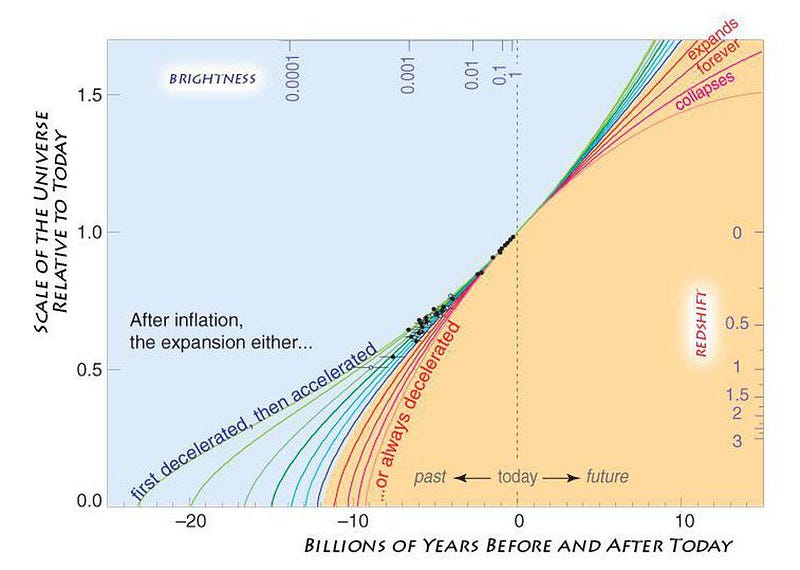
If we want to understand what the Big Rip is, the first thing we need to understand is the motivation for considering it: the evidence for the existence of dark energy. If you imagine the Universe as it was a long time ago, back in the earliest stages of the hot Big Bang, you’d find that there were two different effects vying for domination.
- There’s the initial expansion rate, which works to drive everything apart as quickly as possible.
- And opposing it, there’s the gravitational effects of all the matter and energy in the Universe, working to pull everything back together and recollapse the Universe.
Most of us would imagine three different possible fates, akin to the fable of Goldilocks and the Three Bears. Perhaps the expansion rate is too great for the matter and energy in the Universe, where the expansion rate drops but never reaches zero, as distant objects continue to recede forever. Perhaps the expansion rate is too small, leading to the Universe expanding to some maximum size, then contracting, recollapsing and ending in a Big Crunch. Or perhaps the Universe is “just right,” where the expansion rate and the gravitational effects of everything balance perfectly; one more atom and it would’ve recollapsed, but instead we’re just one atom away from that fate.
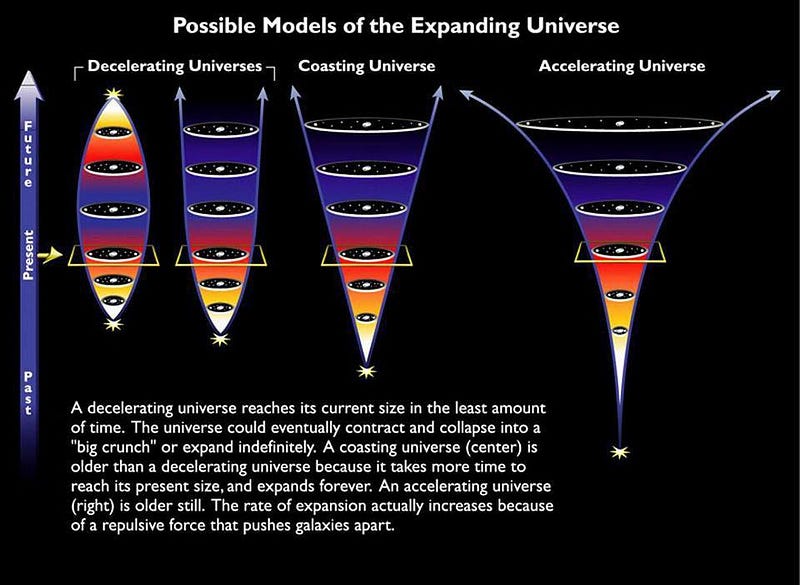
But what we observe the Universe to be doing is consistent with none of them. For the first few billion years, it appeared to be consistent with that “perfectly balanced” scenario, but then something strange occurred. If you had been watching any particular galaxy, you would’ve seen the effect of the expanding Universe imprinted in that galaxy’s light: from the time the light is emitted until the time the light is received, the expanding Universe stretches that light’s wavelength, causing it to be systematically shifted towards the red.
The amount of redshift is related to the cumulative amount of expansion that has occurred, and can be equated with an apparent recession velocity. Over time, if you were to measure that redshift for any object at all, you would’ve seen:
- it started out very large,
- decreased steadily over time,
- appearing like it was going to asymptote to zero,
- and then, all of a sudden, stopped decreasing after reaching some minimum value,
- and began slowly but steadily increasing once again,
- where it continues to increase, all the way to the present day.
What’s remarkable is that this effect cannot occur in a Universe governed by General Relativity if it only contains matter (both normal and dark) and radiation. Spatial curvature can’t account for it, either. In order to explain this observed phenomenon, some fundamentally new form of energy is required: what we call dark energy today.
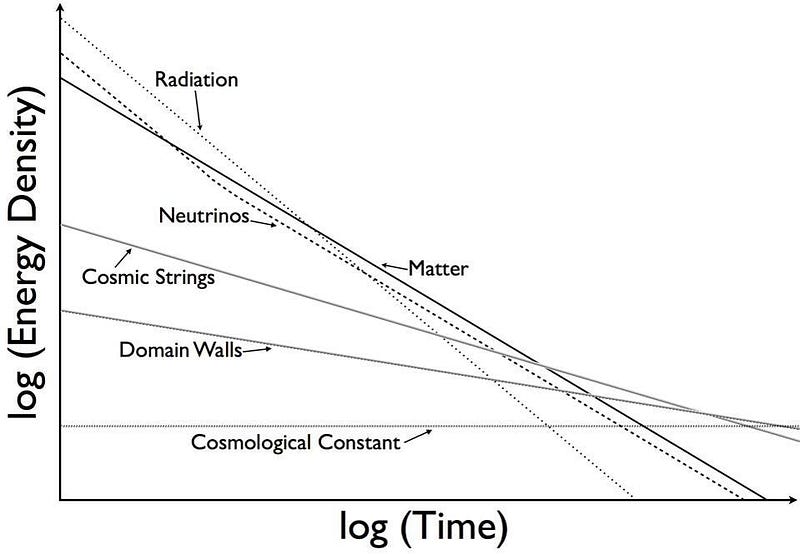
Perhaps the most popular — and certainly, by many metrics, the most compelling — candidate explanation for dark energy is that it’s simply a cosmological constant: a form of energy with a constant energy density everywhere that’s found evenly all throughout space. If dark energy is either:
- the cosmological constant from General Relativity,
- the zero-point energy inherent to space from quantum field theory,
- or another type of field, akin to a scalar or pseudoscalar field, that coupled equally to the Universe at all locations and at all times,
then it simply maintains a constant energy density, and would cause all gravitationally unbound objects to accelerate away from one another at a constant rate: with their recession velocity increasing linearly with time.
If this is an accurate description of dark energy, then the fate of our Universe is known to some high level of precision. All of the structures which are currently gravitationally bound, like solar systems, galaxies, and groups/clusters of galaxies, will remain gravitationally bound, with the largest bound structures never becoming bound to one another. Things will continue to expand, and the expansion will continue to accelerate, until every transition that can possibly occur happens, and no further energy can be extracted from any physical process in the Universe.
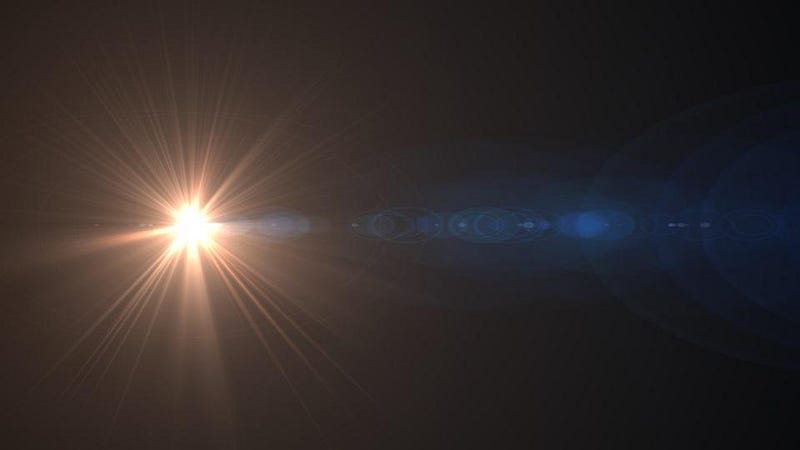
But this doesn’t have to be the case. Our best observations — from distant individual objects, from the large-scale structure of the Universe, and from the temperature and polarization data from the cosmic microwave background — when they’re all combined, teach us that dark energy is consistent with a cosmological constant to a precision of about ±8%. However, it’s still possible that dark energy is an evolving, dynamical quantity, but simply evolves in a fashion that’s below the current observational threshold for detection. (NASA’s upcoming Nancy Roman telescope, slated for launch in the mid-2020s, will measure dark energy down to ~1–2% precision.)
If dark energy does evolve, then it’s possible that:
- it will decay away entirely, returning us to that “just right” Goldilocks case,
- it will weaken and then reverse sign, leading our Universe to contract in a Big Crunch after all,
- or, perhaps most fascinatingly, it could increase in strength over time, with its energy density rising as the Universe continues to age.
That final possibility, where dark energy strengthens over time, is the one that leads to a Big Rip: where structures that would otherwise be stable in the Universe reach an inevitable point where the expansion of the Universe can eventually tear them all apart, each and every one.
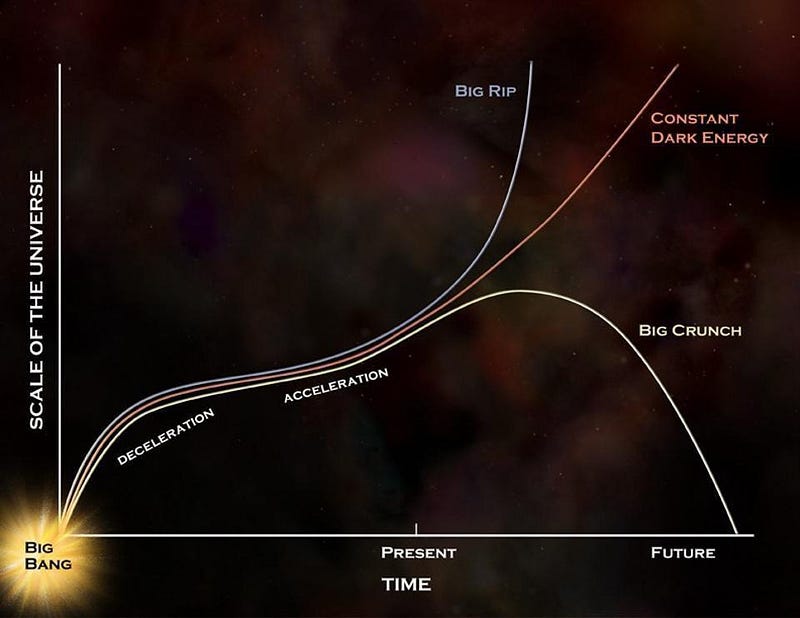
For many, many billions of years, the only difference between a Universe with constant versus increasing dark energy will be in how the expansion rate changes: how severely the light from distant objects gets redshifted. With constant dark energy, the redshift increases linearly with time, whereas with increasing dark energy, the redshift increases at a greater-than-linear rate with time. This increase, if it occurs without any cap or limit on it, will eventually start to affect these large, bound structures in a rather unpleasant way.
First, the largest, most extended galaxy clusters will start to dissociate, as the outer galaxies become unbound from the cluster as a whole, hurled off into intergalactic space.
- Next, the closer, more compact portions of clusters and eventually galaxy groups get ripped apart as well, until all we have left are individual galaxies.
- Afterwards, the individual galaxies will have their dark matter, gas, and eventually stars ripped out of them: from the outside-in. The outskirts of the galaxies are stripped away first, but eventually even the cores of galaxies are stripped down to their individual star systems.
- Then, close to the end, individual solar systems are torn apart. The icy bodies of the Oort cloud are stripped away, followed by the Kuiper belt objects, then the outer planets, the asteroid belts, and even the inner planets.
- Finally, the individual structure like planets and moons are ripped apart into their constituent components.
In the penultimate instants of the Universe, molecules are torn apart into their individual atoms, electrons are stripped off of their nuclei, and atomic nuclei are ripped apart into protons and neutrons, which are then ripped apart into quarks and gluons, just moments before the fabric of space and time itself is demolished by dark energy.
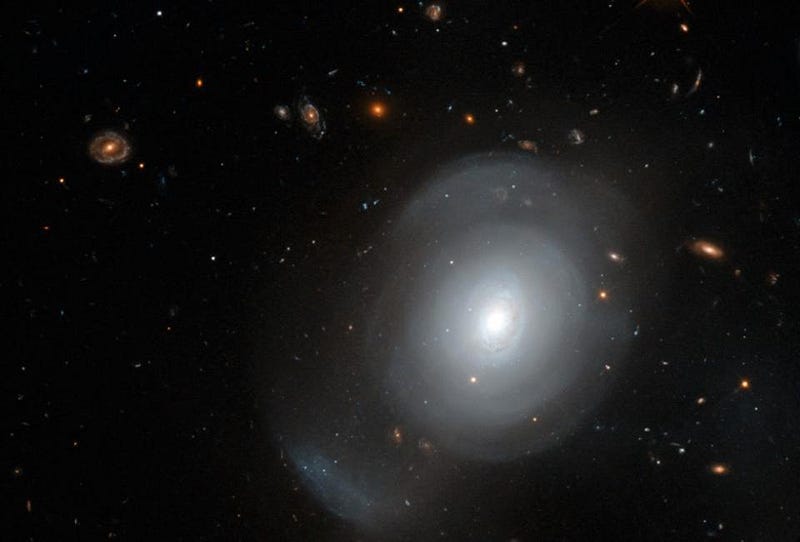
Although this might sound like a far-fetched scenario, you must remember that if dark energy strengthens over time, and you have no restriction on the amount of time that can pass, then all of these occurrences are simply inevitable: the only question is when.
Fortunately, dependent on the nature of dark energy and how its strength changes over time, we can calculate how long it will be before each step occurs. When it was originally proposed, that first step could have occurred as soon as ~22 billion years from now, but that’s been pushed out to some ~60–80 billion years from now, at minimum.
However, once that first step occurs — tearing apart structures on scales of about ~20 million light-years — everything else proceeds rather quickly. Dark energy needs to strengthen tremendously to start overcoming the immense force of gravity, and once it can do so for the most loosely-bound structures, we’re talking only hundreds of millions of years before all of the galaxies are torn out of their home groups and clusters.
Then, it’s only tens of millions of years until stars are ripped out of their individual galaxies.
Next, it’s only a few months until the outer planets are ripped away from their parent stars, and weeks before the inner planets suffer the same fate.
It’s only in those final few minutes that our planet itself will be torn apart, and fractions-of-a-second for molecules, atoms, and more to be ripped apart. The greater the amount of force and energy is required to tear something apart, the less time there is remaining until the Universe itself comes to an end.

Which brings us to an important question: if you’re going to trigger a nuclear fission reaction with the Big Rip scenario — where the subatomic particles at the heart of each atom’s nucleus are ripped apart into their constituent components — how much time do we have for that explosion to propagate throughout space before the Universe itself ends?
For nuclear explosions, the propagation time can be devastatingly fast. The above high-speed photographic sequence shows one of the original test detonations of an early atomic bomb in the 1940s, and you can see that in mere milliseconds, the explosion has expanded to take up a volume that’s larger than the size of a football field: over 100 meters across. It’s a rapidly expanding explosion resulting from a tremendous release of energy, but it’s still slow (less than 1%) of the cosmic propagation limit set by the speed of light.
Unfortunately, by the time atoms and atomic nuclei themselves get torn apart, we’re only ~10^-19 seconds away from the end of the Universe. Even if the released energy traveled outwards at the speed of light, it would only travel about a third of an Ångström through space before the Universe came to an end.

This comes as a disappointment to most people. Sure, it’s fascinating to think about “alternative fates” to the mainstream for our Universe, but that requires something exotic: that dark energy be something even more bizarre and mysterious than is commonly thought. While either the cosmological constant or the zero-point energy of the quantum vacuum can be folded into our current theories without adding anything novel, something that causes dark energy to strengthen over time would require some type of new field, particle, or interaction.
Once you’re willing to invoke such an entity, however, a number of fascinating possibilities for the fate of the Universe suddenly arise. They include:
- the Universe spontaneously transitioning to a lower-energy state, looking very much like a repeat of the end of inflation that kicked off the hot Big Bang,
- the act of tearing space apart resulting in a sort of “reverse singularity,” where space and time can either be reborn or can disappear into nothingness,
- or the Universe actually undergoing a cyclic phenomenon, where a closed time-like loop ensures that the Universe plays again on repeat, just as it did before, except with the quantum outcomes of various interactions being no more pre-determined than they were in this iteration of the Universe.
The Big Rip is one possibility for how the Universe could end, but if dark energy increases with time, we have to face the facts: at some point, we’re going to have to deal with energies and temperatures that are high enough that we’ve never explore them. In those regimes, anything that’s not ruled out remains possible.
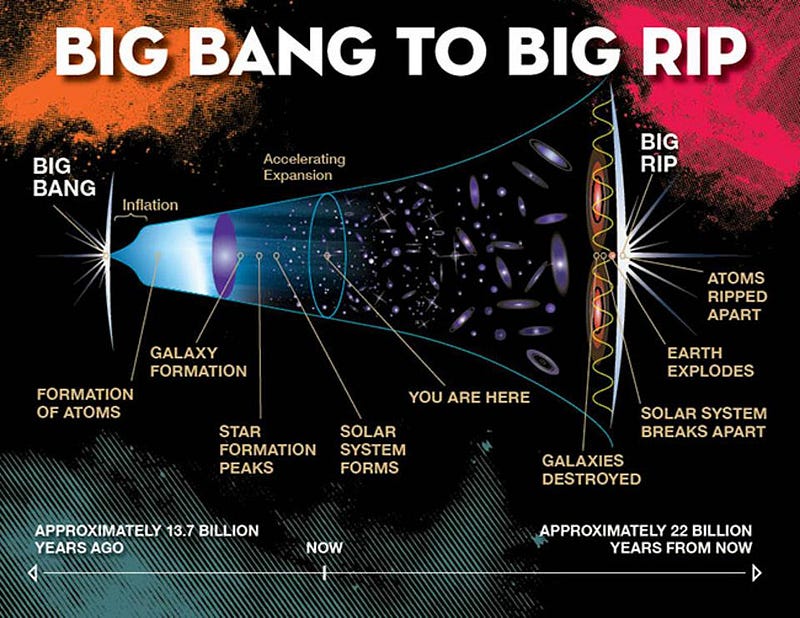
The truth of the matter is that we know so little about the nature of dark energy that all we have to go off of is what observations tell us must be — and, correspondingly, what cannot be — true. There really must be some new form of energy in the Universe present, and it cannot be some form of matter, radiation, or spatial curvature. It must be distributed evenly throughout space and cannot be tied to matter. And it must be, within the limits of our present observations, consistent with a cosmological constant, or a form of energy inherent to the fabric of space itself.
But beyond that, we don’t really have good constraints. Dark energy could have been present or absent during the first ~50% of the Universe’s history after the Big Bang. Dark energy could be a leftover relic from the early days of inflation. Dark energy could be an emergent phenomenon that only became important recently. And dark energy could be constant and unchanging, or it could be slowly strengthening, weakening, or setting itself up for a transition far in the future from now.
Whenever we find ourselves in a situation like this, scientifically, the only responsible option is to go out and gather more, superior data to help guide us in our quest to understand what’s going on. If dark energy changes over time, it’s measurements, not any theoretical gymnastics, that’s going to guide our way. Until we know something more than we do today, all we can do is remain open to the possibilities, while simultaneously taking the simplest explanation as the most likely. All of that could change in very short order, however. When it comes to unjustified assumptions, we must always exercise caution, as the Universe has surprised us before, and most likely, will do so again.
Send in your Ask Ethan questions to startswithabang at gmail dot com!
Starts With A Bang is written by Ethan Siegel, Ph.D., author of Beyond The Galaxy, and Treknology: The Science of Star Trek from Tricorders to Warp Drive.





